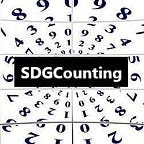SDG 1 Indicators- 2017 Updates
The updated list of SDG #1 Indicators since July 2016, with changes highlighted.
In summer 2016, we created a series of Medium stories listing the targets and indicators for the Sustainable Development Goals. Since then, meetings have been held that have altered and edited the global indicators framework. Here, we highlight the changes and additions that have been made since July 2016 up to April 2017, to update our indicator stories before the High Level Political Forum takes place in July 2017.
*Changes and additions to indicators are italicized, along with notes from the IAEG-SDGs as to the purpose of the edit. Changes begin at Target 1.5.
SDG 1: No Poverty — Indicators by Target
Target 1.1. By 2030, eradicate extreme poverty for all people everywhere, currently measured as people living on less than $1.25 a day
Indicator 1.1.1: Proportion of population below the international poverty line, by sex, age, employment status and geographical location (urban/rural)
Target 1.2. By 2030, reduce at least by half the proportion of men, women and children of all ages living in poverty in all its dimensions according to national definitions
Indicator 1.2.1: Proportion of population living below the national poverty line, by sex and age
Indicator 1.2.2: Proportion of men, women and children of all ages living in poverty in all its dimensions according to national definitions
Target 1.3. Implement nationally appropriate social protection systems and measures for all, including floors, and by 2030 achieve substantial coverage of the poor and the vulnerable
Indicator 1.3.1: Proportion of population covered by social protection floors/systems, by sex, distinguishing children, unemployed persons, older persons, persons with disabilities, pregnant women, newborns, work-injury victims and the poor and the vulnerable
Target 1.4. By 2030, ensure that all men and women, in particular the poor and the vulnerable, have equal rights to economic resources, as well as access to basic services, ownership and control over land and other forms of property, inheritance, natural resources, appropriate new technology and financial services, including microfinance
Indicator 1.4.1: Proportion of population living in households with access to basic services
Indicator 1.4.2: Proportion of total adult population with secure tenure rights to land, with legally recognized documentation and who perceive their rights to land as secure, by sex and by type of tenure
Target 1.5. By 2030, build the resilience of the poor and those in vulnerable situations and reduce their exposure and vulnerability to climate-related extreme events and other economic, social and environmental shocks and disasters
Indicator 1.5.1: Number of deaths, missing persons and directly affected persons attributed to disasters per 100,000 population
Previous Indicator: number of deaths, missing persons and persons affected by disaster per 100,000 people — — multipurpose indicator
Sendai modification; Reviewed at 5th IAEG-SDG meeting; Repeat of 11.5.1 and 13.1.1
Indicator 1.5.2: Direct economic loss attributed to disasters in relation to global gross domestic product (GDP)
Previous Indicator: Direct disaster economic loss in relation to global gross domestic product (GDP) — — multipurpose indicator
Sendai modification; Reviewed at 5th IAEG-SDG meeting
Indicator 1.5.3: Number of countries that adopt and implement national disaster risk reduction strategies in line with the Sendai Framework for Disaster Risk Reduction 2015–2030
Previous Indicator: Number of countries with national and local disaster risk reduction strategies
Sendai modification; Reviewed at 5th IAEG-SDG meeting; Repeat of 11.b.1 and 13.1.2
Added Indicator 1.5.4: Proportion of local governments that adopt and implement local disaster risk reduction strategies in line with national disaster risk reduction strategies
Sendai modification; Reviewed at 5th IAEG-SDG meeting; Repeat of 11.b.2 and 13.1.3
Target 1.a Ensure significant mobilization of resources from a variety of sources, including through enhanced development cooperation, in order to provide adequate and predictable means for developing countries, in particular least developed countries, to implement programs and policies to end poverty in all its dimensions
Indicator 1.a.1: Proportion of domestically generated resources allocated by the government directly to poverty reduction programs
Previous Indicator: Proportion of resources allocated by the government directly to poverty reduction programs
UNSC 48 Refinement; Reviewed at 5th IAEG-SDG meeting
Indicator 1.a.2: Proportion of total government spending on essential services (education, health and social protection)
Added Indicator 1.a.3: Sum of total grants and non-debt-creating inflows directly allocated to poverty reduction programmes as a proportion of GDP
UNSC 48 Refinement; Reviewed at 5th IAEG-SDG meeting
Target 1.b. Create sound policy frameworks at the national, regional and international levels, based on pro-poor and gender-sensitive development strategies, to support accelerated investment in poverty eradication actions
Indicator 1.b.1: Proportion of government recurrent and capital spending to sectors that disproportionately benefit women, the poor and vulnerable groups
